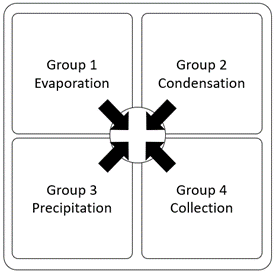Unit 1: Water Sustainability and Awareness
Introduction
Through this unit you will be introduced to the topic of water sustainability, why water conservation is important and the idea of a water footprint as a measure of water use/waste.
Activity 1.1
Read through Unit 1 Presentation slides 3-4. Using the data provided, work in pairs to complete the following problem:
- If a 1L bottle is used to represent the total surface water on the earth, how many ml of this would make up the planet’s usable water supply?
- Compare your answers with those of other groups? Discuss the answers in relation to the availability of freshwater for human consumption.
Activity 1.2
Read through slide 5-7 of Unit 1 Presentation.
Working in pairs, choose one of the four processes which make up the water cycle and write a causal explanation and share it using Google Jamboard (or other platform).
Complete this quiz to revise how matter changes state.
Carry out the investigation which pertains to the water-cycle process you have already chosen. Complete the relevant worksheet.

Read through slides 9 – 12 of Unit 1 Presentation, watching the two videos on slide 10. Write a causal explanation for what you observe in the videos. Present your explanations to the group. Compare your explanations to that presented in slide 13 of Unit 1 Presentation.
Return to the causal explanation of your chosen water-cycle process. Update the explanation you initially wrote on Google Jamboard, using all you have learned throughout this activity.
Get together with three other groups (see diagram) to share your learning from this activity and your causal explanations of each water-cycle process. Provide feedback to the other groups on their causal explanation. Listen to feedback on your causal explanation. Compare your approaches to writing a causal explanation. Refine your causal explanation and update it on Google Jamboard.
Activity 1.3
In pairs, using bubbl.us, create a mindmap, which outlines all that you know about water. Share your mindmap with the rest of the class using Google Jamboard.
Develop your understanding of states of matter further by completing this interactive activity based around an online simulation.
Activity 1.4
Read through slides 17-19 of Unit 1 Presentation. Watch the two videos on the impact of drought, on slide 18.
Review slide 20 of Unit 1 Presentation and estimate how much water you flush down the toilet each day assuming you flush:
- 3L every time you do a “number 1” and
- 6L very time you do a “number 2”
Compare your result to other students in your class. Are there any obvious trends? Who uses more water per day, boys or girls?
Activity 1.5
Part 1:
Part 1: Review slides 21-22 of Unit 1 Presentation.
Watch this video, which introduces the concept of water footprint.
Examine the list of foods in part 1 of this spreadsheet. In pairs, estimate which water-footprint category, each food belongs to (note the water footprint categories are included in the spreadsheet). Fill your predictions into the relevant column in the spreadsheet.
Compare your choices to other students in your class and discuss why you chose to put certain foods in a given category.
Compare your predictions to the correct answers, which are included on slide 21 of Unit 1 Presentation.
Answer the questions on the spreadsheet and discuss with the whole class.
Part 2:
Read this article on the steps each of us can take to reduce our water footprint on slide 22 of Unit 1 Presentation.
Using the same spreadsheet and this water footprint data source, estimate the water footprint of each of the three lunch boxes.
Answer the questions in the spreadsheet and discuss with the whole class.
Part 3:
Using the same spreadsheet, estimate the water footprint of each person in your group.
Answer the questions in the spreadsheet and discuss with the whole class.
Activity 1.6
What are the major contributors to water footprints?
How can you reduce your water footprint?
Share your thoughts with the rest of your class by posting them to this jamboard.
Discuss the different ideas / suggestions.
The water footprint activities are based on this article referenced on slide 24 of Unit 1 Presentation.
Activity 1.7
Reflect on your learning throughout Unit 1, by downloading and completing this learning log. Share your reflections with your tutor.
